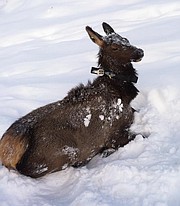Fish and Game: Helicopter elk surveys begin from North Fork to St. Joe River valley
Along with the helicopter pilots that will whisk them into North Idaho’s backcountry, Fish and Game biologists are on standby as the department’s annual elk survey is set to begin.
The helicopter surveys that cover a swath from the North Fork of the Coeur d’Alene River to the St. Joe River headwaters will start as soon as the weather allows, biologist Kiira Siitari said.
The new model being used by the department to survey elk populations in Units 4, 6, 7 and 9 includes collaring calves, and monitoring the calf and adult populations, Siitari said.
That means game managers will no longer be flown around the units in inclement winter weather, searching for elk and counting what they see.
Instead, biologists will dart calves with tranquilizers and put collars on them so they can be monitored through the winter. If they survive, the elk can be tracked further to their summer range and fall ranges.
That way, Siitari said, a model of elk survival and movement can be established and used in the future.
“We’re building a database of where elk hang out and where they move over time,” she said.
Since the program began a few years ago, 160 calves have received collars and another 60 are set to be collared this winter. Biologists watch the collar for signs of mortality and once a calf is down, biologists are flown to the area to retrieve the collar and investigate the cause of the animal’s death.
“Usually it gets busy in the late spring when the animal’s reserves are depleted,” she said.
The new survey techniques began when Fish and Game decided that surveying calves for mortality rates and cause of death was more relevant because cow mortality, even in winter, was relatively low.
Another aspect of the elk study uses camera grids to take pictures of elk movements. The department continues to set out game cameras in a grid pattern in elk country that are used to count elk. The method is less dangerous than having biologists fly during the winter.
Fish and Game biologists Larry Barrett, 47, and Danielle Schiff, 34 of Lewiston and helicopter pilot Perry J. Krinitt, 43, of Belgrade, Mont., died in a copter crash in 2010 near Kamiah.
One person was killed a year ago in a helicopter crash near Lewiston during an Eastern Washington deer survey contracted by Washington’s Department of Fish and Wildlife. Two others were injured in the crash.
For the time being, helicopter crews will continue to fly over the Silver Valley, North Fork Coeur d’Alene River and St. Joe River drainages to capture and collar elk for the sixth year of an ongoing elk survival study.
The collars are made to expand as the animal grows and will eventually drop off male calves as they mature, but will remain on cows, Siitari said.
Since 2014 when the study began, annual cow elk survival has been steady at 94 percent. Survival has been lower and more variable for calves, between 40 to 80 percent, regional wildlife biologist Barb Moore said.
“The long duration of snow in low elevations the last two winters caused some calves to burn entirely through their fat reserves, which also increased their vulnerability to predators” Moore said.
The mortality studies help determine if wolves, mountain lions or bears killed the calves, or whether the animals were sick, had parasites or low fat stores.



